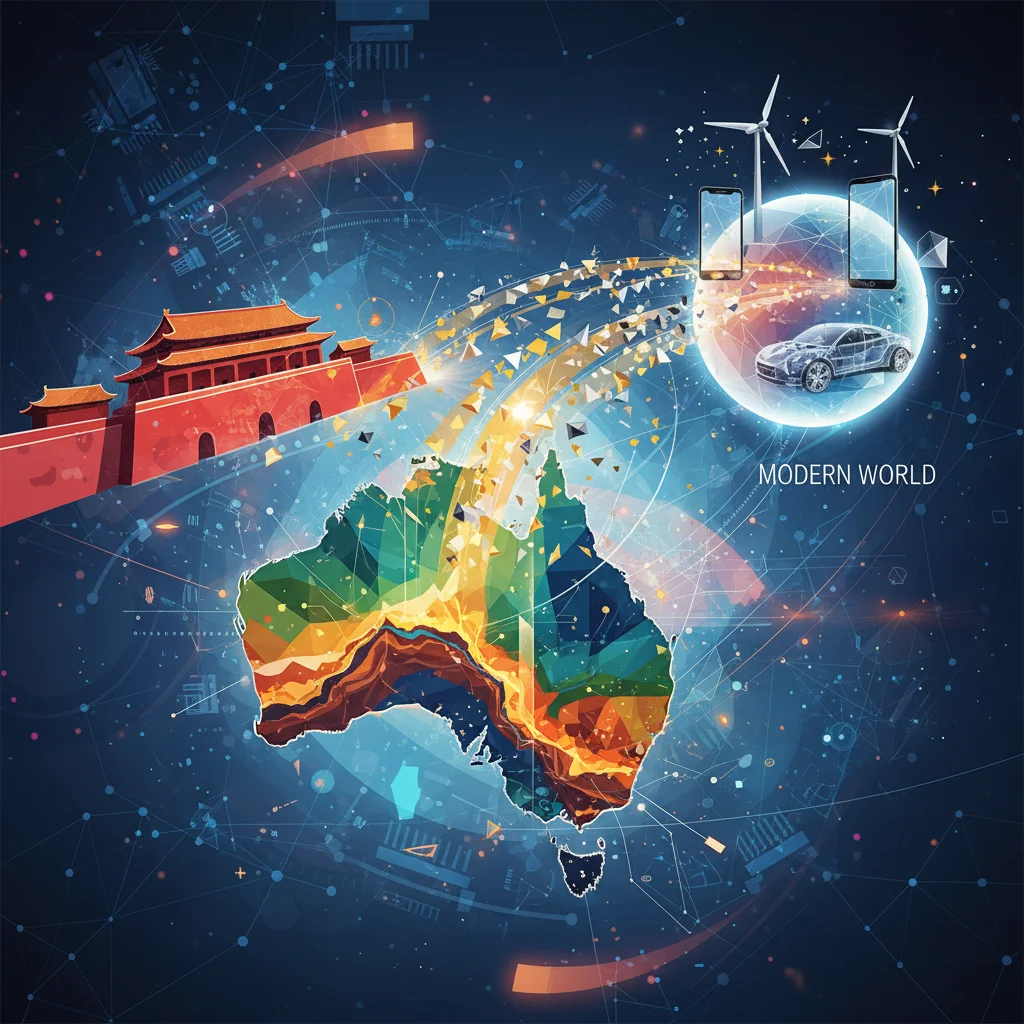
Beyond Beijing: Why Australian Rare Earths Are the Hottest Ticket in Geopolitical Investing
The Unseen Engine of Our Modern World
Look around you. The smartphone in your hand, the electric vehicle gliding silently down the street, the massive wind turbines dotting the landscape—they all share a secret. Buried deep within their complex circuitry and powerful magnets are a group of 17 metallic elements known as rare earths. They are the “vitamins” of modern technology, indispensable ingredients that make our most advanced innovations possible. Yet, the global supply of these critical materials is overwhelmingly controlled by a single nation: China.
This concentration of power has set the stage for one of the 21st century’s most critical economic and geopolitical showdowns. As tensions between Washington and Beijing escalate, the United States and its allies are in a desperate race to break this dependency and secure their own access to the building blocks of the future. In this high-stakes global chess match, a new kingmaker has emerged from an unlikely corner of the globe: Australia. Down Under, a select group of mining companies are being hailed as “rock stars,” thrust into the limelight as the Western world’s best hope for a secure, reliable, and friendly supply chain. For savvy investors and business leaders, this shift isn’t just a news headline; it’s a fundamental reshaping of the global economy, creating unprecedented opportunities in the stock market and commodity trading.
China’s Stranglehold: A Decades-Long Strategy
To understand the opportunity, one must first grasp the problem. China’s dominance in the rare earth elements (REEs) market is no accident. It’s the result of decades of strategic industrial policy, state subsidies, and, historically, less stringent environmental regulations. This has allowed Beijing to control nearly every stage of the supply chain, from mining the raw ore to the complex and often dirty process of separating it into usable oxides and, finally, manufacturing the high-performance magnets used in everything from F-35 fighter jets to MRI machines.
The numbers are staggering. While China accounts for around 60% of global rare earth mining, its dominance in the midstream processing stage is near-total, controlling an estimated 80-90% of the global supply. This gives Beijing a powerful geopolitical lever. By threatening to restrict exports, as it has done in the past, China can potentially cripple Western defense manufacturing, derail green energy transitions, and disrupt the production of consumer electronics. This strategic vulnerability is a risk that Washington is no longer willing to tolerate.
Below is a simplified look at the applications of some key rare earth elements, illustrating their importance to modern industry and defense.
| Rare Earth Element | Key Applications | Strategic Importance |
|---|---|---|
| Neodymium & Praseodymium | High-performance magnets for EV motors, wind turbines, consumer electronics (headphones, hard drives) | Critical for the green energy transition and high-tech manufacturing. |
| Dysprosium & Terbium | Additives that allow magnets to retain their properties at high temperatures | Essential for military applications (missile guidance, drones) and high-performance electric vehicles. |
| Yttrium & Europium | Used in lasers, superconductors, and as red phosphors in LED screens and lighting | Key to advanced medical equipment, displays, and energy-efficient lighting. |
The Stealth Tax Squeeze: Why the UK's Shrinking CGT Threshold is a Bigger Deal Than You Think
Washington’s Response: The Rise of “Friend-Shoring”
Faced with this stark reality, the U.S. has embarked on a multi-pronged strategy to de-risk its supply chains. The goal is not necessarily to bring all production back onshore (“reshoring”) but to shift it to trusted allies—a concept known as “friend-shoring.” At the top of that list of friends is Australia.
Canberra and Washington are now key partners in a concerted effort to build a viable ex-China supply chain. This partnership is not just diplomatic talk; it’s backed by substantial capital. The U.S. Department of Defense has been actively funding Australian projects, recognizing that national security is inextricably linked to mineral security. For example, Lynas Rare Earths, the largest non-Chinese producer, has received significant funding to build processing facilities in Texas, directly integrating Australian-mined materials into the American industrial base (source). This strategic alignment represents a powerful tailwind for Australian miners, transforming their geological assets into geopolitical ones.
Australia’s New “Rock Stars”: The Companies Leading the Charge
The geopolitical shift has catapulted a handful of Australian companies from relative obscurity into the global spotlight. These firms are no longer just digging rocks out of the ground; they are critical cogs in the future of Western technology and defense. Their success on the stock market reflects this newfound importance.
Leading the pack is Lynas Rare Earths (ASX: LYC), which operates the high-grade Mt Weld mine in Western Australia and a processing plant in Malaysia. As the only significant producer of separated rare earths outside of China, it has become the cornerstone of America’s diversification strategy.
Another major player is Iluka Resources (ASX: ILU), a mineral sands company that is developing the Eneabba refinery, also in Western Australia. Backed by a A$1.25bn loan from the Australian government, this project aims to produce separated heavy and light rare earths, further solidifying the country’s role in the supply chain.
This table provides a snapshot of the key Australian players at the forefront of this global shift.
| Company | Key Asset(s) | Strategic Importance | Recent Developments |
|---|---|---|---|
| Lynas Rare Earths | Mt Weld Mine (WA), Kuantan Plant (Malaysia), Kalgoorlie Facility (WA) | Largest integrated rare earths producer outside of China. | Receiving U.S. DoD funding for a Texas processing facility. |
| Iluka Resources | Eneabba Refinery Project (WA) | Developing Australia’s first fully integrated refinery for rare earths. | Secured a A$1.25bn loan from the Australian government. |
| Arafura Rare Metals | Nolans Project (NT) | A significant undeveloped deposit of neodymium-praseodymium (NdPr). | Secured offtake agreements with Hyundai and Kia. |
The Legal Slingshot: How Class Actions Empower SMEs Against Corporate Goliaths
The Broader Financial Landscape: From Geopolitics to Your Portfolio
This realignment of critical supply chains is about more than just mining; it’s a macro trend with profound implications for `finance`, `investing`, and the global `economy`. The flow of capital is being redirected by government policy, creating a new paradigm for project `banking` and resource `finance`. Projects that were once considered uneconomical are now deemed strategically essential, unlocking new avenues of funding.
For investors, this presents a unique sector that sits at the intersection of technology, commodities, and geopolitics. The `trading` activity around these stocks is increasingly influenced by diplomatic cables as much as by quarterly earnings reports. Moreover, the push for supply chain integrity is accelerating innovation in `financial technology`. There is growing discussion around using `blockchain` to create immutable records of provenance, allowing end-users like EV manufacturers or defense contractors to verify that their materials are ethically sourced and, crucially, not from China. This use of `fintech` for supply chain transparency could become a new industry standard, adding another layer of value to non-Chinese producers.
Beyond the Headline: Why a Simple Chart Correction Unlocks the Real Story of Economic Uncertainty
Conclusion: The Dawn of a New Economic Era
The race for rare earths is a microcosm of a much larger global story: the fragmentation of a once-interconnected world into competing economic and strategic blocs. The days of chasing efficiency and the lowest cost at any price are being replaced by a new focus on resilience, security, and trust. In this new era, geology is destiny, and Australia’s rich deposits have placed it at the center of the free world’s plans for the future.
While the path ahead is fraught with challenges—from technical hurdles and environmental concerns to the ever-present risk of shifting political winds—the direction of travel is clear. The world is actively building a parallel supply chain for the most critical materials on earth, and Australian miners are providing the foundation. For those in the world of `finance` and `economics`, this isn’t just a trend to watch; it’s a fundamental re-wiring of the global industrial machine, with opportunities and risks that will define the market for decades to come.


